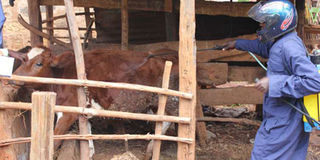Practices that will make your animal healthy and happy

Ticks cause diseases such as East Coast Fever while tsetse flies trypanosomiasis. Regular use of acaricides is recommended. Use acaricides that do not leave chemical residues in milk. PHOTO | FILE
What you need to know:
- Trimming hooves with cracks require zinc supplements to firm them up and prevent future cracking. Trimming hooves infected with foot rot requires that you dip the feet in copper sulphate solution available in agrovets. Poor or over-trimming can result to lameness.
- When applying any of the methods, be careful to avoid causing pain or distress to the animals. Anti-inflammatory drugs may be required during ear-tagging and tattooing. Where paints are used for marking, ensure that you use non-toxic ones.
- Some de-wormers cause miscarriages to in-calf cows, therefore, deworming post-calving at around early lactation is safer and consistently increases milk yields. Administer the de-wormers at three months interval.
Dairy cattle management include proper feeding, milking techniques and hygiene. In addition there are a number of things that help make the cow comfortable. These are:
Dehorning and disbudding
Disbudding is the removal of the horn buds. It is usually done before three weeks of age to male and female cattle. When buds are left to grow, they develop into horns and the practice of removing them is called dehorning.
These is mainly done for the safety of the rest of the herd since some animals are aggressive. However, disbudding is more recommended over dehorning since it is less invasive.
Before removing the horns, restrain the animal in a humane manner and arm yourself with a hot de-budding iron. It is better to do a painless procedure than to provide post-operation pain relievers.
Use anaesthetics, sedatives and anti-inflammatory agents to reduce pain. Disbudding should always be done by a vet to avoid re-growth of buds into horns. Observe disbudded calves up to two hours, if there is head-pressing or abnormal head tilt, call the vet back for re-examination.
Hoof trimming
This helps to control abnormal growth of hooves that cause lameness. If not trimmed regularly, hooves get deformed and the cattle remains pre-disposed to foot rot, abscesses or foot puncture, false pad and foot injuries. You should trim heifers at four to six months, thereafter, carry out the activity when necessary.
Frequently monitor the growth of your herd’s foot and trim when applicable to make the animals more comfortable to stand for a longer time. If you wait, foot cracks emerge.
You need a sharp knife or hoof-nipper, hoof pick, rasp and a pair of gloves to protect your hands.
Trimming hooves with cracks require zinc supplements to firm them up and prevent future cracking. Trimming hooves infected with foot rot requires that you dip the feet in copper sulphate solution available in agrovets. Poor or over-trimming can result to lameness.
Castration
This is normally done to young males not intended for breeding purposes. Castration involves removing testicles through open surgery, cords crushed by use of a burdizzo or blood flow restricted to the testes using rubber rings. Sedatives and anaesthetic drugs are used during the procedures, which should be done by a qualified vet, to ease pain.
Identification and branding
Animal identification is mostly important for traceability, identity and keeping accurate records. In cattle, ear tags or tattoos are used. Though branding is mainly done in beef cattle, it is seen in some dairy farms but it is not recommended.
When applying any of the methods, be careful to avoid causing pain or distress to the animals. Anti-inflammatory drugs may be required during ear-tagging and tattooing. Where paints are used for marking, ensure that you use non-toxic ones.
Ear tags are installed when animals are still young.
Hair trimming
This is removal of hair from coats, tail switch and udder. Cows may carry pathogens on their tail switch and infect the udder. Udder and coat hair accumulate dirt and manure and also make acaricide penetration difficult.
Off-milk flavour risks are also high where udder hairs are left to grow. Tail switch trimming is mainly done two to three times in a year, coat hair once a year and udder hair on a regular schedule. Electric shavers are mostly used.
External parasite control
They include ticks, flies, fleas and mites. If the host is burdened, it loses weight, diarrhoea, loss of hair and scratching against the wall. Ticks cause diseases such as East Coast Fever while tsetse flies trypanosomiasis.
Regular use of acaricides is recommended. Use acaricides that do not leave chemical residues in milk and have least impact on the environment. It is important that you do not spray your animals within the unit, but in a crush if using a knapsack or spray race.
Alternatively, take them to a cattle dip. Dress in an overcoat, gumboots and nose mask when spraying. Also recommended is that you rotate the acaricides you use to reduce chances of resistance by parasites. Spray regularly; after one or two weeks.
Internal parasite control
These are mainly roundworms, tapeworms and flukes. Worms compete and drain the animal’s nutrients resulting to poor health, slow growth rate and low productivity. Where regular deworming is not practised, symptoms include dull and rough coats, hair loss, coughing and distended abdomens.
Some de-wormers cause miscarriages to in-calf cows, therefore, deworming post-calving at around early lactation is safer and consistently increases milk yields. Administer the de-wormers at three months interval.
Extra teat removal
Supernumerary teats develop away from the four primary teats. Normally, they pause risk for bacterial infection and make milking difficult. In case you identify extra teats, call a vet to remove them when the animal is still a calf for easy control of bleeding and pain.
Weighing
Most diseases or conditions are manifested by weight losses, therefore, any significant loss should raise alarm. In the absence of scales, use weight bands .





